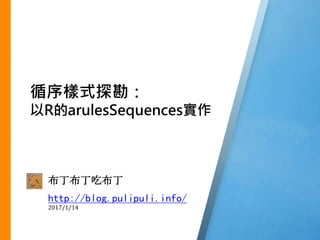
20170114 循序樣式探勘:以r實作
- 4. 定義:序列、項目集 ●一個序列 (sequence) 是項目集 (itemsets)的有序串列 (ordered list) ○序列 S 被表示成 <s1,s2,…,sn>,其中si (1< i ≦ n) 是項 目集。 ○例如,<{10, 20},{30},{90}> 是一個序列, 其中{10, 20}、{30} 以及 {90} 皆是項目集。™ ○{10,20}項目集中包含了{10}跟{20}這兩個項目集 4
- 5. 定義:包含、子序列 ●包含:序列 <{a1},{a2},…,{an}> 被包含在序列 <{b1},{b2},…,{bm}> 中,假如存在整數 i1<i2< …<in 滿足 ○序列 <{10},{90}>被包含在 <{10, 20},{30},{90}>中 ○<{10},{90}>不被包含在 <{10, 90}>。 這是因為在序列 <{10},{90}> 中,項目集 {10} 和 {90} 是先後在不同交易中被購買的。 ●若序列S包含序列S’, 則稱序列S’為序列S的 「子序列」 (subsequence)。 5
- 6. 定義:k-序列、最大序列 ●一個包含 k個項目集的序列稱之為k-序列 (k-sequence) ●給定一組序列S,若序列S不被包含在其它序列中, 則稱它為 「最大序列」 (maximal sequence)。 ○每一個最大序列則代表一個 循序樣式 (sequential pattern)。 ○例如兩個序列: 2序列:<{10},{90}> 3序列:<{10, 20},{30},{90}> 3序列不被包含在其他序列中,它就是最大序列 6
- 7. 定義:顧客序列 ●對於每一個顧客,將他所有的交易根據交易時間排序所 得到的結果就是一個「顧客序列」。 7 會員帳號 顧客序列 1 <{10,20},{30},{40,60}> 2 <{10,20},{30},{90}> 3 <{30},{90}> 4 <{10,20,30}> 5 <{30},{60,90}>
- 8. 定義:支持度、最小支持度 ●一個序列 S的「支持度 (support)」被定義為「包含S的 顧客序列之總數佔全部顧客總數的比例」。 ○有多少比例的顧客都會做這樣的序列 ●若序列滿足使用者設定的「最小支持度」 (minimum Support) 之限制,則稱之為 「大型序列」 (large Sequence)。 ○一旦發掘所有的大型序列之後,就能夠輕易產生所有 的最大序列。 ○循序樣式探勘的問題就是要找出所有的循序樣式,也 就是所有的最大序列。 8
- 10. 範例:顧客序列資料庫 10 會員帳號 顧客序列 1 <{10,20},{30},{40,60}> 2 <{10,20},{30},{90}> 3 <{30},{90}> 4 <{10,20,30}> 5 <{30},{60,90}>
- 11. 範例試算 ●設定最小支持度為0.2:因為會 員帳號總數為5,所以最小支持 個數需大於5*0.2=1。 ●序列 <{30}> 和 <{30},{90}> 的支持個數分別為5和3,支持 度為1跟0.6,所以它們都是大 型序列。 ●結果:最大序列為<{30},{90}> ○序列 <{30}>不是最大序列, 因為它被包含在大型序列 <{30},{90}> 之中。 11 會員 帳號 顧客序列 1 <{10,20},{30},{40,60}> 2 <{10,20},{30},{90}> 3 <{30},{90}> 4 <{10,20,30}> 5 <{30},{60,90}>
- 12. 12 以R實作arulesSequences Data Mining Algorithms In R /Sequence Mining/SPADE https://en.wikibooks.org/wiki/Data_Mining_Algorithms_In_R/Sequence_Mining/SPADE
- 15. 1. 配置腳本與資料 15
- 16. 2. 準備資料集 input.csv 16 1 2 3 1.使用者代號 2.時間 3.事件 (用空白區隔)
- 20. 6. 輸出結果 20
- 21. 7. 解釋結果 21 score sequence _length support sequence score sequence _length support sequence 1.5 3 0.5 <{P},{F},{A}> 1 2 0.5 <{P},{B}> 1.5 3 0.5 <{P},{B},{A}> 1 2 0.5 <{B},{A}> 1.5 3 0.5 <{P},{B,F},{A}> 1 2 0.5 <{F},{A}> 1 1 1 <{A}> 1 2 0.5 <{P},{A}> 1 1 1 <{B}> 1 2 0.5 <{B,F},{A}> 1 1 1 <{F}> 0.75 1 0.75 <{A,F}> 1 1 1 <{B,F}> 0.75 1 0.75 <{A,B,F}> 1 2 0.5 <{P},{F}> 0.75 1 0.75 <{A,B}> 1 2 0.5 <{P},{B,F}> 0.5 1 0.5 <{P}> score 最大&支持度高 =sequence_length*support
- 22. 7. 解釋結果 22 score sequence _length support sequence score sequence _length support sequence 1.5 3 0.5 <{P},{F},{A}> 1 2 0.5 <{P},{B}> 1.5 3 0.5 <{P},{B},{A}> 1 2 0.5 <{B},{A}> 1.5 3 0.5 <{P},{B,F},{A}> 1 2 0.5 <{F},{A}> 1 1 1 <{A}> 1 2 0.5 <{P},{A}> 1 1 1 <{B}> 1 2 0.5 <{B,F},{A}> 1 1 1 <{F}> 0.75 1 0.75 <{A,F}> 1 1 1 <{B,F}> 0.75 1 0.75 <{A,B,F}> 1 2 0.5 <{P},{F}> 0.75 1 0.75 <{A,B}> 1 2 0.5 <{P},{B,F}> 0.5 1 0.5 <{P}> 1 10 2 C P 1 15 3 A B C 1 20 3 A B F 1 25 4 A C P F 2 15 3 A B F 2 20 1 E 3 10 3 A B F 4 10 3 P G H 4 20 2 B F 4 25 3 A G H
